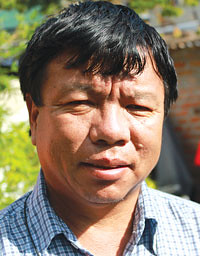Mahabir Pun needs help to scale up his award-winning work in a remote Myagdi village to the national level

ALL PICS: KISHOR RIMAL
Mahabir Pun won the Ramon Magsaysay
Award in 2007 for his project to bring wireless Internet to rural Nepal, but he found out last week that the Internet was also a great way to remotely get through to the prime minister.
Pun had met Prime Minister Baburam Bhattarai a year ago to discuss his pet idea to set up a National Innovation Centre to promote creativity and generate jobs so Nepalis don’t have to migrate abroad for work. Bhattarai had nodded, said it was a great idea and instructed his office to implement it.
As expected, nothing happened. Whenever he came to Kathmandu from his native village in Myagdi, Pun followed up with the ministries and all he got was smiles, pats on the back, and nodding of heads.
Last week, Pun vented his frustration with a direct Tweet to the Prime Minister’s Twitter handle, @brb_laaldhwoj, and through a message posted on the listserv of NNSD (Nepal Network for Social, Economic and Environmental Dialogue) whose members include Nepal’s top academics, civil society activists, politicians, and bureaucrats.
‘After talking to responsible political leaders, high level bureaucrats, development agencies, and educated elites in Kathmandu for more than a year, I have a feeling now that nobody cares about the immense need of one innovation centre in Nepal in order to uplift Nepal from a beggar nation to a well-to-do nation,’ Pun began his passionate appeal.
He went on to lament that while donor agencies poured billions of dollars into Nepal, no one seemed interested in stemming the haemorrhage of working age people out of the country. He said he was shocked to read in the papers that the cabinet had sanctioned Rs 3 billion to buy helicopters for the Nepal Army.
‘If the government has that much money to buy helicopters, how come it cannot provide half a billion rupees as loan to help start an innovation centre?’ Pun asked.
Pun has registered a non-profit company called Nepal Abiskar Kendra with noted ex-bureaucrats like Rameswor Khanal, the man behind the Chilime Project, Dambar Nepali, and others in the advisory board. The plan is to build a 10MW hydropower plant, and sell electricity worth $6 million a year to the grid.
That money will be used to service the loan and run the centre sustainably into the future. It will use information technology to help creative Nepalis with financing and know-how to launch businesses. Pun is seeking a soft loan of $6 million for equity to build the hydropower plant, either from the government or a multilateral donor.
Pun posted his message on the NNSD bulletin board at 7:45PM on Friday, and within three hours there was a SMS from the Prime Minister’s Office summoning him to Baluwatar the next morning. This was surprising because the all-party negotiations on setting up a CJ-led election government were reaching a critical stage.
Pun cleared security to enter Baluwatar, and within five minutes Bhattarai was there with Finance Minister Barsha Man Pun, Chief Secretary Krishna Hari Baskota, and the PMO Secretary Lila Mani Poudel. The PM began by saying he had read Pun’s Twitter message and fully agreed with the concept of a Nepal Innovation Centre, and he asked the Finance Minister how the government could support it.
The meeting dragged on for an hour, and Pun remembers that as expected the minister and the secretaries had no concrete ideas about how the government could help finance the 10MW power plant. But before the entire PMO, including the prime minister, went off for a picnic in Godavari, the meeting agreed to invite the World Bank, ADB, and other multilateral agencies to push the idea.
“It will be a miracle if the Secretary finds a single donor to contribute a soft loan for the innovation,” Pun told Nepali Times, “let’s wait and see.”
As a boy, Mahabir Pun used to graze sheep in the high meadows near the village of Nangi below the Annapurnas. Going to school, he had no pencil or textbooks. Most of his neighbours became British Gurkhas, but Pun got an education and a scholarship in the University of Nebraska.
Unlike most other Nepalis, however, Pun returned to Nepal. He didin’t just come back to Kathmandu but went back to Nangi to see how Information Technology could help his community leapfrog into the Internet age.
With the Nepal Innovation Centre, Mahabir Pun is trying to scale up what he has done in Nangi to a national level. His plan may have a better chance of being funded under a technocratic government than under one led by political parties. Or better still, Pun should be a part of the technocratic government?
www.nepalwireless.com.np
See also:
Mahabir's Centre for Nepal Connection
Beyond the digital divide
Web pioneer